Support Early Literacy Offline
Sometimes, it’s better to unplug. But with quarantine, it can be hard to do! To help, our librarians have put together this collection of Early Literacy activities and parent tips for kids 1-5 years old. We’ve focused on activities that use supplies you may have on hand or can easily recreate. Don’t be afraid to get creative and replace suggested materials with what you have available.
Early Literacy
Early Literacy is built up through five key practices–reading, talking, writing, singing, and playing!* One of the best ways to make sure your child is ready to read and ready for kindergarten is to make sure they are regularly have opportunities to do all five key practices, whether with you, friends, or at the library. Parents and caregivers are a child’s first and best teachers! Every little bit you can do with them at home goes a long way!
| Reading Tips | Reading Activities | Talking/ Singing Tips |
| Make Instruments and Music From Story Times | Writing Tips | Writing Activities |
 Reading Tips
Reading Tips
Many children love hearing their favorite stories over and over. Please don’t be afraid to keep reading whatever books you have on hand. At this age, children should start to learn the names and sounds of the letters of the alphabet and what they look like.
Read Everywhere Reading is not just for books. What letters can your child point out on the containers of their favorite snacks? What letters are on the T-shirt dad is wearing today? Point out letters and important words (like their name, Pawling, or hello) wherever you can.
There’s lots of ways to get kids moving while they learn their letters. If you’re looking for a way to make letter learning more active and playful, check out these ideas. Click the links for more information and pictures!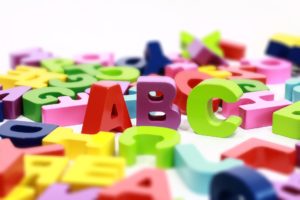
Alphabet Find and Learn Write out each letter on a post-it or piece of paper and tape them around your play space. Challenge your child to search out the letters you’ve “hidden” with you! When you’ve found them all, move them around and start again. Got a younger child? Focus on just a few letters at a time and go back to them repeatedly, being sure to search together.
Alphabet Target Practice Got a bean bag, soft ball, or small stuffed animal? Tape pieces of paper with letters up to the walls or down to the floor and challenge your child to hit the letters you call or point out with their soft toy. When they hit the letter, celebrate! Focus on just a few letters at a time to make it easier for your child to learn the letters.
Alphabet Relay Kids love the back and forth movement in this game! To play, you’ll need a set of letters and a space you can run in. If you have letter magnets, puzzle pieces, or blocks, this is an awesome use of them! You can also use post-its or written out letters, too.
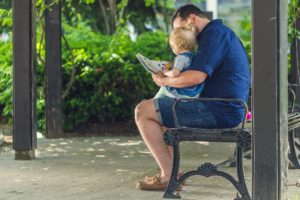 Talking and Singing Tips
Talking and Singing Tips
No matter what you’re working on, talk or sing about it! Whether your child talks constantly or only has a few words in their vocabulary, they benefit from talking and singing with you. Talking and singing teach turn taking and conversation and new words and ideas!
Talking
A great way to introduce your child to new words and concepts is by narrating everything you do. Point out details in book illustrations or photographs, like the names of animals and colors. Name the objects you interact with everyday, like their toys, pets, and furniture. Ask questions about your environment, your child’s feelings–everything! Even if you have the same conversation six times, it’s great talking practice.
Giving your child choices is another easy way to introduce them to new words and ideas. Ask questions with options, like “Do you want the green toy or the red toy?” or “Should we eat oatmeal or strawberries?” Providing options lets you keep your child’s attention on the topics and words you want them to learn, while making them think critically about what they want/need.
Singing
Singing slows down words and lets children hear the sounds that make them up. It’s fun to introduce new and important vocabulary with songs! Songs with movement and action, like Head, Shoulders, Knees, and Toes, or We’re Going on a Smooth Road are especially good for learning new words.
Don’t be afraid to sing or play the same songs over and over. The repetition is great for this age group!
Music and Rhymes We Love
Check out our Bouncing Rhymes page for lyrics to many of the rhymes and finger plays we use in story times.
Feeling like you need a dance break? Our librarians have also curated a list of favorite music recordings including many we use in story time! Put on some early literacy friendly jams and dance around together. You can even grab a scarf or streamer and wave with it, just like we do with scarves in story time!
Make your own instrument
We love shakers! They help us make singing even more fun, and work children’s motor control. We’ve collected links to our favorite craft shaker ideas below. Check them out if you don’t have a shaker or maraca at home to play with. Making an instrument can also be a fun activity for any day stuck inside.
- Rice and paper plate shakers – You can sub rice for beans or lentils, too! These do tend to leak, so they are best for children 3-5 years old, and stapling should be done with a grown-up!
- Easy plastic bottle shakers – You can also use dry rice, small rocks collected outside, or anything else that makes a fun noise! If your child is under 3, we recommend taping or hot gluing these bottles closed.
- Easter Egg Shaker – Small enough for little hands to hold and quick to make, these are family favorites.
- Rainstick Shaker – These shakers make a really fun sound and are calming for kids to watch. You can sub plastic straws, crinkled aluminum foil, or pipe cleaners for sticks, too if you have them.
Writing Tips – We love scribbling!
Before they know how to write or draw, children scribble. Scribbling is great practice for later writing skills! It teaches children how to use pencils, and how to form shapes and letters. Encourage your child to scribble and praise them for it.
Ready to take it to the next level? Ask your child, “What are you making?” If they don’t have a set idea in their head, make a suggestion of something they can write or draw. Attaching meaning to scribbles is the next step to learning that letters represent sounds and pictures represent ideas.
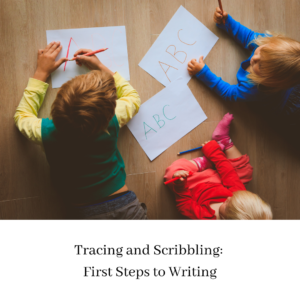 Tracing is easy
Tracing is easy
Got old bills or notes lying around you don’t need? A spare notebook? Tracing is a great skill to practice, and you can use whatever materials you have laying around! Draw or print large, clear letters on paper, carboard, or on the sidewalk in chalk.
Start by drawing the letter yourself and telling your child exactly how you draw it. Talk about where you start and end (for example, “To make the letter T, you start at the top and draw a line down…Great job! Then you go back to the top and add another line like a hat on top!”).
Have the child trace over what you made on their own–first with their finger and then with a marker, crayon, or pencil. It’s okay if it isn’t perfect! If you get through 1- 3 tracings at a time that’s great progress! Have your child practice each letter on their own or scribble freely after completing the traced letter(s).
Looking for a printable version of this activity? Check out Preschool Play and Learn’s version, which you can print and use or laminate to use again and again with dry erase or washable markers.
Sensory Tracing
One kid-favorite way to practice tracing is with sensory materials. Got some hair gel you never use or leftover sprinkles from birthdays past? There’s lots of ways to utilize these materials and others to practice writing.
The two most popular are to make sensory bags and sensory writing trays. The same ingredients can be used for both, but if you want to keep the mess contained, just put the ingredients in a bag before handing them over. Take a look at how we used shaving cream to do both a sensory tray and a sensory bag.
When choosing whether to make a bag or a tray consider your child. Do they still try and put everything in their mouth? Try a bag. Do they love touching messy things? If yes, consider the tray. The mess is worth it!
Sensory Bags
To make a sensory bag for tracing, you’ll need a plastic ziploc bag (preferably gallon size) and a sensory material to put in your bag (see the list below for ideas!). Our favorites are shaving cream or sprinkles. Kids can also use a pencil, chopstick, or paintbrush to help push on the bag to draw the letters if desired. We suggest grown ups tape the bag to the floor or table with packing, masking, or duct tape for an added layer of security and stability. If you don’t have tape, this will still work.
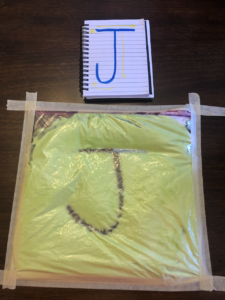
We used shaving cream and green food coloring for this sensory bag.
- Add your sensory material. Be careful not to overfill–add enough that the whole bag appears full when laid flat but you can still draw on it and the shape of the letter will appear.
- Seal tightly. Tape seal closed for extra security, and tape the bag to your workspace.
- This activity works best when your bag is placed on a surface that is a different color than your sensory material. We put our white shaving cream on our brown table instead of the tan floor to help it stand out and make it more fun.
- Introduce the bag to your child and give them time to explore it on their own and ask questions.
- Show your child an example of the letter you want them to make. This example could be on a phone or tablet or drawn on a piece of paper. Show and tell how to create the symbol you are working on as you draw it. For example, “To make the letter T, you start at the top and draw a line down…Great job! Then you go back to the top and add another line like a hat on top!”
- Get your kid involved–ask them what letters or words they want to practice next! Kids often like writing things that matter to them, like the letters in their names or the names of loved ones.
Sensory Trays
To make a sensory tray, you’ll need a tray, bin, or child-safe plate. A cookie baking sheet makes a great tray! You’ll also need a sensory material to put in your tray (see the list below for ideas!). We also suggest kids use a pencil, chopstick, straw, or paintbrush to make the letters with. Be sure not to fill the container too much — you want to be able to see what you’ve made.
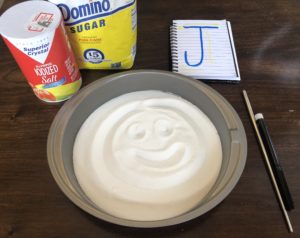
Sensory writing with sugar
Sensory Materials List
Here’s a short list of sensory materials great for sensory trays and bags. Links lead to examples of their use.
- Rice
- Sugar
- Salt
- Sprinkles
- Sand
- Shaving cream
- Hair Gel or shampoo
- Chocolate syrup
- Glitter
- Pudding
- Oatmeal
- Flour and water
Letter Play
There are lots of ways to play with letters! Any time you build the shape of a letter out of sensory or play materials, like play dough or rocks and sticks, you’re helping your child learn. This type of play and writing will help them learn to recognize the shapes letters make! Take a look at how we’ve done letter play in the library and at home
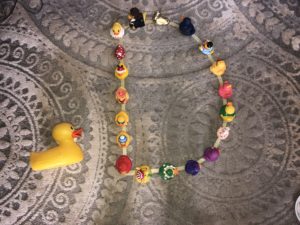
D is for… Duck! Quack!
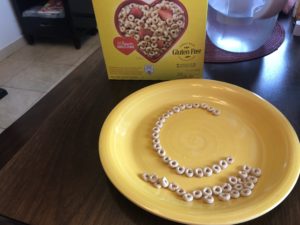
Cereal C’s
Check out this quick video from Every Child Ready to Read!* for even more ideas on fun ways to work letter play into your time at home.
Every Child Ready to Read® @ your library® is a program of the Association for Library Service to Children and Public Library Association, divisions of the American Library Association. Every Child Ready to Read® @ your library® is a registered trademark and is used with permission.
